Essential Outcasts
To outside observers, the gangs of hired laborers at construction sites or in farm fields seemed to be members of a single category: tramp. However, casual workers themselves pointed out vital differences within their caste, often using a three-line rule of thumb:
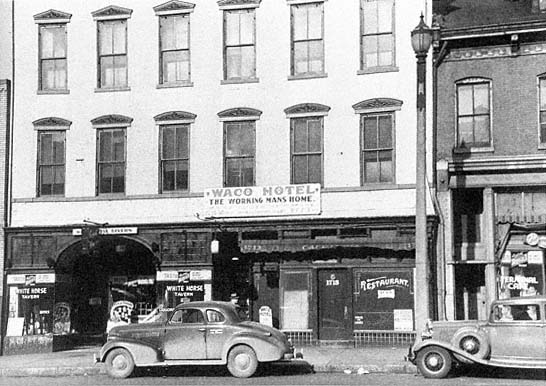
Figure 5.2
The Waco Hotel, St. Louis. When photographed in 1939, rooms were 25¢, 35¢, and 50¢ a day.
Note the tavern and restaurant on its ground floor.
A hobo works and wanders.
A tramp dreams and wanders.
A bum drinks and wanders.[2]
All three groups of men appeared unattached to a family; they had few possessions, enjoyed recreational drinking, worked intermittently, and traveled often. People in the categories of tramp and bum did the most to give casual laborers a bad reputation, yet they made up only a small share of the whole group, for instance, only 2,500 out of Chicago's 100,000 casual workers. Tramps and bums were migrant non workers, often dirty and slovenly. Hoboes were workers who often shared or aspired to many middle-income values.[3] Together, hoboes, tramps, and bums represented a hotel group that writers—historically as well as today—have erroneously called "homeless men." The casual laborers who lived in cheap lodging houses were no more homeless than the mining kings or opera divas who lived in palace hotels (fig. 5.2). Hotels were also an integral part of the casual labor supply and its culture.
Nels Anderson, a hobo who later went on to become a University of Chicago sociologist, defined the true hobo as the "in-between worker, willing to go anywhere to take a job and equally willing to move on later." In rural and remote wilderness locations, hoboes dug ditches, carted bricks, and tended animals in the construction of mines, railways, highways, and oil fields. In farm regions, hoboes followed the harvests of grain, corn, fruit, potatoes, beets, cotton, or hops. During the winter, smaller numbers of men did lumbering or cut ice. According to Anderson, most boys or men moved out of the hobo work force within ten years of entering it.[4] In city locations, gangs of casual workers toiled over the menial tasks involved with building industrial plants and street railroads, paving streets, laying pipe and wire for gas and electric systems, and erecting new buildings. Casual laborers were also former carnival workers, part-time sailors, and extra hands for industrial and shipping peaks at docks, warehouses, and factories (fig. 5.3).[5] In the 1920 census, San Francisco registered over 17,000 general laborers and another 7,000 people working as longshoremen and sailors (table 4, Appendix).
In the economy of the nineteenth century and early twentieth century, demand for hobo labor fluctuated wildly, even in comparison with the unstable work conditions for skilled workers. A bumper crop, a new railroad company, sudden demands for lumber, or an oil boom instantly employed thousands of new people and created the need to house them. Just as instantly, business downturns wiped out those positions. A slowdown in 1908 meant that American railroads employed 236,000 fewer men than they had employed the year before. When work was plentiful, hoboes came to the city to sign up at employment agencies catering to casual laborers; the agencies then sent them back out to distant labor sites. Some California farm workers migrated to and from the same San Francisco hotel for over fifty years.
Due to the fluctuation of casual laborers' work, summer occupancies in cheap lodging houses could drop to 40 percent of capacity. When rural work for casual laborers declined sharply in the winter months, large numbers of hobo laborers returned to the city. By late November, urban lodging houses were at full occupancy and beyond. Lodging house keepers doubled up people in rooms and set more cots out into the hallways. The residents lived as long as possible on their summer earnings and picked up odd jobs, but winter urban work was also
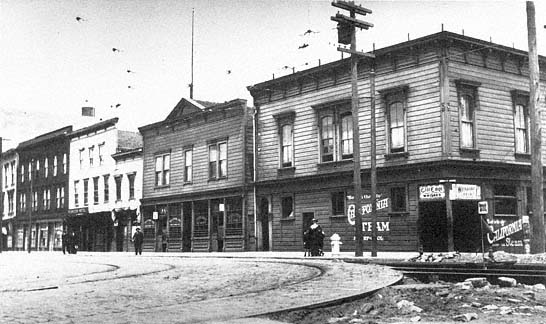
Figure 5.3
Sailors' boardinghouses photographed in 1913, Steuart Street, San Francisco. These waterfront structures
had survived the fire of 1906 and could thus remind San Franciscans of Victorian hotel slums.
scarce. During January, February, and March, industrial employers in San Francisco cut their work forces by an average of one-fourth (a cut of 12,000 jobs in 1921).[6] Cheap lodging houses were also permanent residences for stationary casual laborers or the "home guard," men spending some stationary years before resuming hobo life or formerly migrant men too old or unwilling to go back on the road.
Urban casual laborers were paid by the day and lived by the day. Often resisting the tedium of a steady job, they worked from a day to a week at jobs. Their indoor work included stints as porters, janitors, waiters, dishwashers, or potato peelers. In "King of the Road," Roger Miller summarized the immediate work-hotel relationship: in 1964, "two hours of pushing broom" bought an "eight by twelve four-bit room."[7]
Photographs and reports from the turn of the century show that workers' hotel districts were not full of elderly, hard-drinking men, as the 1950s stereotypes of those districts suggest. Riis declared in 1890 that he found a high proportion of able-bodied men in New York's Bowery—"young men, unsettled in life, . . . fresh from good homes, beyond a doubt with honest hopes of getting a start in the city and making a way for themselves" (fig. 5.4).[8] At the turn of the century, at least one casual laborer out of eight might be under twenty years of
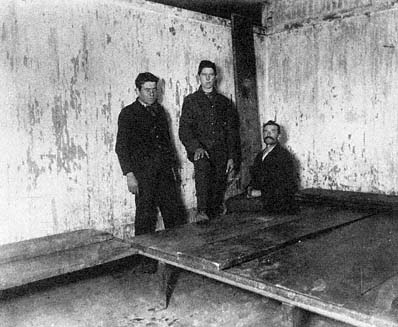
Figure 5.4
Police station lodgers, including two young men. In the 1890s,
Jacob Riis photographed the bare comforts of this police station
lodging room in New York City, where he had slept in 1870.
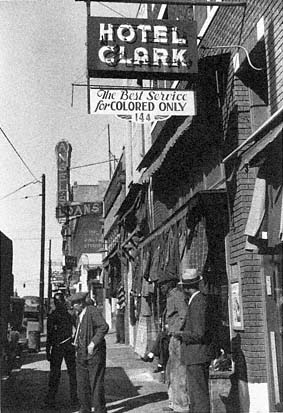
Figure 5.5
Racial segregation in cheap lodging houses.
A hotel on Beale Street in Memphis, Tennessee, 1939.
age, and most were in their middle years. After World War II, the elderly proportion increased; in Sacramento in 1953, men over fifty-five comprised about one-third of the lodging house population.[9]
In some regions of the United States, new immigrants and racial minorities made up significant parts of the casual labor markets. In 1880, a fourth of San Francisco's hired laborers were single Chinese men no longer sent out to do far-flung railroad and field work. They comprised almost 90 percent of the 3,000 employees in the cigar and tobacco industry and over half the labor force in the boot and shoe manufactories. A dual labor agency system prevailed in San Francisco through the 1920s; Japanese and Chinese workers were hired from "Oriental" employment agencies.[10] In other cities, blacks were the more significant racial minority in the single laborer population, and blacks had the most trouble finding housing. In 1925, a black carpenter complained to authorities that he was unable to secure a lodging house room in San Francisco; all the cheapest hotels had drawn the "color line" (fig. 5.5).[11]
Before World War II, in spite of the notable presence of minority casual laborers, in large cities most casual laborers were white and American-born. They were usually in-migrants from the countryside, where mechanization had made them superfluous. Almost all had permanently separated from their families. In fact, these were distinctly non family, nonhousehold people. The few who had wives or children were rarely in contact with them and had cut off most other typical family ties as well.[12]
When a lifelong single laborer became feeble or too old for hard physical work, he survived with odd jobs and rough domestic work such as raking leaves or shoveling cinders. As such work gave out, as it did during the 1930s when younger men competed for marginal jobs, the older men went on starvation economy programs, moved to the cheapest lodging houses, lived on as little as 25 cents a day, and then pawned what they could of their possessions (including overcoats and eyeglasses) to pay their hotel bills, trusting to odd jobs for their food. As a last resort, single laborers applied for work or aid at a mission, a Salvation Army wood yard, or a soup kitchen. After age sixty-five, all but the strongest were forced to go to an almshouse or hospital for at least part of the year.[13]
Although lodging houses were overwhelmingly a male workers' realm, women lived there as well. In 1890, a San Francisco reporter
asked the keeper of a 10-cent lodging house what he did when women applied for a room. "If they've got the money [15 or 20 cents] we try and put them in a room by themselves," answered the desk clerk. When the reporter asked what happened if they did not have the money, the clerk replied, "Well, if they've only got ten cents, or the other rooms are full, they have to take their chances with the rest."[14] Women were as many as one out of ten migrant workers during the depression; national estimates then ranged from 14,000 to 50,000 women on the road. In New York City's Bowery district, perhaps the nation's most famous lodging house zone, out of the sixty-three cheapest hotels, three were for women and four for boys. In most cities, commercial and social services for women were not nearly as well developed as those for men. Bertha Thompson, better known as Box-Car Bertha, wrote about using women's informal information networks to find urban housing, often shared with other women.[15] Nonetheless, cheap lodging house districts had the most skewed gender distribution of all types of residential hotel areas, as shown in a series of age and sex pyramids drawn for Chicago in 1920 (fig. 5.6).[16] Even in the cheap lodging house pyramid, with its dramatic curve for men, women make up a clearly discernible proportion, many of them living in small dilapidated rooming houses that had sunk to lodging house prices and standards.
Urban lodging houses also served as repair stations for work place casualties. In the decades when few employers paid for incapacitating injuries at work and when few workers had a labor union or insurance, handicapping accidents or job-caused diseases sent thousands of single workers each year to permanent hotel life in the city. Casual laborers knew the county hospitals, dispensaries, and medical colleges in large cities. In 1911, according to Alice Solenberger's study of one thousand men in Chicago's cheap lodging houses, one-fourth were either temporarily crippled or permanently maimed.[17]
The most desperate lodging house denizens were those whose incomes made housing hard to find and who in addition had the bad luck, marginal psychiatric state, or personal weaknesses to keep them out of all housing except commercial hotels, police stations, or public institutions. These outcasts often became permanently unemployed and castigated as "industrially inefficient." Solenberger deduced that 9 percent of the dependent tramps and bums—the people who dreamed and drank more than they worked—did so because they were mentally ill.
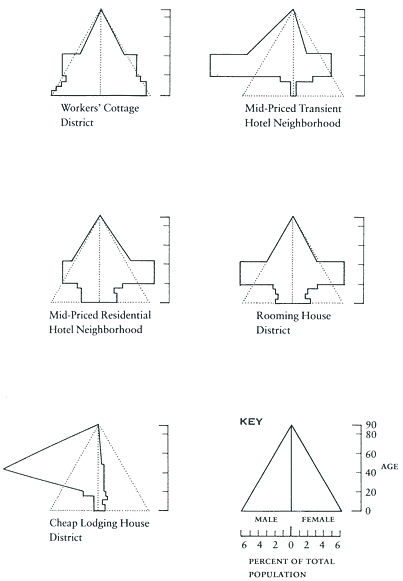
Figure 5.6
Age-sex pyramids for Chicago hotel neighborhoods in 1920.
Dotted lines indicate the national average, with young people at
the base, elderly at the top. Males are on the left of each pyramid,
females on the right. Men particularly predominate in cheap lodging
houses; women are prominent in rooming houses and midpriced areas.
Heavy drinking also led to underemployment of hotel residents, although only a tenth of the drinkers in lodging houses may have been true alcoholics. Reports of cocaine, heroin, or morphine addiction also came from the cheap lodging houses more often than from the more polite hotel ranks.[18]
Low-caste professional crooks found both shelter and a continual supply of hapless victims in cheap hotels. When migrant workers got to town, the tricksters and prostitutes were ready for them. Robbing men while they were drunk or asleep became something of a specialty near lodging houses. Narcotics sellers, bootleggers, and pickpockets could also be found in hotel areas of all sorts.[19] Outside observers assumed everyone was a criminal in San Francisco's Barbary Coast, the zone of rooming houses, boardinghouses, saloons, and manufacturing buildings located between Chinatown and the piers. In cheap San Francisco hotels in the nineteenth century, the verb "to shanghai" replaced "to crimp" for the process of drugging or knocking out sailors and then sending them out to sea as unwilling crews on ships (while the lodging house master pocketed the saved-up pay the sailor had just given him). Reporters said conditions in other ports were similar or worse.[20] On the subject of criminals living in lodging houses, Riis and other reformers loved to quote New York's Police Superintendent Thomas Byrnes, the most famous detective of his era. In the 1880s, Byrnes had traced 27 percent of the city's police book arrests to men who lived in the cheap hotel district. The lodging houses, he said, were "nurseries of crime."[21]
In spite of the dire pronouncements of people like Byrnes and early sociologists, single casual laborers did not lead socially disorganized lives. The historian Robert Slayton has shown how casual laborers thoroughly knew their place within an elaborate social hierarchy. To match the general outline of the workers' social structure and income variations, hotel owners offered a hierarchy of cheap lodging houses.